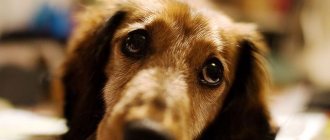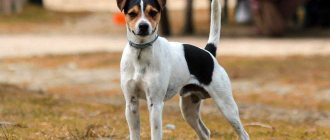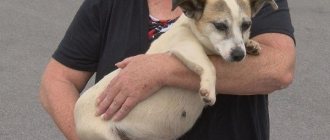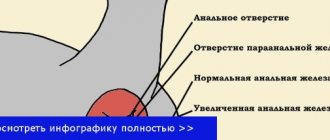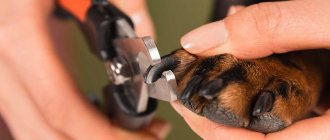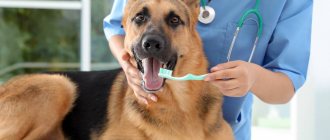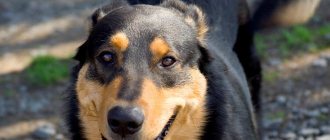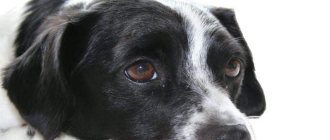Suddenly you notice blood on your dog's paw, he limps and licks his paw. Upon examination, the cause becomes clear - a damaged claw. Nail problems, especially pulled or broken nails, are common in dogs and are rarely life-threatening. However, it is usually very painful.
Nails often get caught in fabric or carpets, and in an attempt to escape, the dog can injure or pull out the nail. You may not notice it until there is blood or the dog starts limping or whining. Without treatment, an injured nail can bleed periodically and become infected, not to mention causing pain and discomfort for your dog.
Nail structure in dogs
The dog's claw consists of hard and spongy parts. The inner material has a pinkish tint and is called the “body”. It contains nerves and blood vessels.
The structure of a dog's claw.
If during a “manicure” the owner accidentally injures his pet, there is no need to worry. Minor bleeding is not dangerous.
Choosing a nail clipper
Despite the extensive range of products, there are only 3 main types of “scissors”: sickle, guillotine and nail files.
1. Sickle-shaped nail clippers are the most familiar and convenient for us. The curved blade allows you to quickly and painlessly remove excess parts.
2. Guillotines have a ring into which you need to insert a claw. This device has a number of disadvantages. Firstly, it is difficult to sharpen. Usually, if the blades become damaged, you have to get rid of the guillotine. Secondly, in the process, the nail cutter literally breaks the tissue, which sometimes causes longitudinal splits.
3. There are 2 types of nail files: automatic and regular. Using a grinder is a real pleasure, but it is not cheap. In addition, some dogs are afraid of vibration and noise. An ordinary rough file for artificial nails will help if the pet categorically does not accept nail clippers. Animals usually agree to a compromise.
How to stop bleeding from a nail
There are 3 proven ways to stop heavy bleeding:
- special pencil;
- antibacterial soap;
- potassium permanganate.
Severe bleeding can be stopped with a special pencil.
In a critical situation, it is necessary to seek the help of a veterinarian.
Using a special pencil
Hemostatic pencil is one of the most effective topical agents . You can buy it at any pharmacy.
Before using the pencil, you need to wet its tip. Then you need to take the dog by the damaged paw, place a pencil on the wound and wait about 120 seconds.
If blood continues to ooze, the procedure will need to be repeated. The time can be increased. In some cases, it takes up to 4–5 minutes to stop bleeding.
If the repeated procedure does not help, you need to contact your veterinarian.
If the pencil does not help, then you need to contact your veterinarian.
Using antibacterial soap
When you press a bar of soap on a dog's claw, a plug is formed that closes the wound . After 3-4 hours it disappears on its own. No additional actions are required.
The soap forms a plug, trapping blood.
The wounded “nail” of your pet must be held perpendicular to the bar of soap. The dog may begin to struggle, so you need to hold it tightly. The claw should be inserted to a depth of approximately 2–3 mm. The paw is held for 2–4 minutes. This helps stop bleeding.
You need to carefully remove the claw from the soap. If there is no soap plug, the manipulation must be repeated.
Application of potassium permanganate
Potassium permanganate will help stop the bleeding.
To carry out the procedure you will need the following:
- potassium permanganate;
- a small amount of water;
- cotton swabs.
Potassium permanganate is a crystalline powder. And it is also available in the form of diamond-shaped crystals of a purple hue.
This is usually the method used by veterinarians to stop bleeding.
- The swab needs to be moistened in water, then dipped in potassium permanganate, applied to the wound and wait 20-30 seconds.
- If blood continues to ooze, the procedure will need to be repeated. You need to hold the tampon for 4–5 minutes.
Paste made from water and flour
A teaspoon of flour is mixed with water to make a paste.
- To prepare this paste you need to mix 1 tsp. flour with the same amount of water.
- Then you need to “arm yourself” with a cotton swab, dip it in the product and press it to the claw. You need to wait 3-5 seconds.
- If blood continues to ooze, the procedure is repeated.
Baking soda
A pet’s bleeding “nail” should be dipped in soda. When a clot has accumulated, the paw can be removed.
The dog's claw should be dipped in baking soda to stop bleeding.
The resulting plug disappears on its own after 30–40 minutes. Baking soda can be replaced with cornstarch. In this case, you will have to wait a little longer for the traffic jam to appear.
Nail trimming and exhibition
It is also best not to trim your dog's nails before a show. If a cut occurs, it may cause lameness and the dog will not be allowed to participate or the overall score will be lowered. Therefore, trim your nails 2-3 days before the exhibition.
There is one clever, painless method that allows you to move the living part of the claw as far as possible. To do this, when processing the plate, you should carefully cut it in a circle from the edge to the center, making the tip of the claw look like a sharply sharpened pencil. This way you won’t have to cut off the central, sensitive part, but, left without reliable protection of the outer stratum corneum, it will easily and neatly grind off when you walk.
Dog nail trimming
nail clipper
A nail clipper is the most common and convenient cutting tool. There are different types of device. The most commonly used are small curved scissors for puppies and small breed dogs or clippers for pets of medium and large size. Acting on the principle of scissors, such mechanisms, made of high-quality steel, quickly and accurately cut off the overgrown part without crushing or deforming the claw.
Guillotines have a slightly different structure. For an even cut, you need to carefully insert the claw into the hole and, after additional testing, trim it. Unfortunately, it is impossible to use such devices without some skill, and the position of the cutting part breaks the tissue at the cut, which can cause a longitudinal split of the plate. By the way, such mechanisms must be quite sharp. If the product becomes dull, it will most likely simply have to be thrown in the trash - guillotines are practically impossible to sharpen.
Guillotine
If the dog has a large mass and also expresses its protest quite actively, there is a high probability that you will not be able to reliably hold it during the procedure using physical force or commands. When using mechanical cutting tools, there is a high probability of injury to the animal, so in this case it is recommended to use electric tools. Most often, these are scratching posts or grinders that have a rotating abrasive disc at the end and do not cut, but file the nail.
If you can't afford an electric grinder, you can use a regular human nail file - just take one that is designed for acrylic variations. Craftsmen often invent homemade devices that consist of a sheet of sandpaper glued to a wooden block, or they use an ordinary file for this purpose.
However, there is another side to the coin. Some owners of show dogs, in order to achieve a neat appearance of the paws and in an effort to give the animal a more well-groomed appearance, cut off the claws almost at the root, causing the pet to experience excruciating pain, both during the procedure and after a long time until the damage heals.
It is absolutely true that after such a radical haircut, the claws do not grow back for a very long time, but what this costs four-legged pets can only be understood by trying to tear off your fingernail to the meat and, repeating the procedure on both hands, then try to work with such limbs. What to do if you injure your dog's claw while grooming
Even without taking into account such a savage method of care, all sorts of injuries often occur during haircuts. If the nail is cut too deep, the dog often experiences pain, and the edge of the nail plate begins to bleed.
A large number of small blood vessels feeding the bed leads to a lot of blood flowing out of one small hole. Sometimes it even begins to beat with jerks, as if a large artery is damaged.
The sight of a bloody stream, combined with the squeaking and squealing of a frightened pet, puts the owners into a state of stupor, for a long time discouraging them from ever touching the pet’s paws.
In fact, everything is not so scary. Here are some useful practical tips that will allow you to quickly and effectively deal with an accident:
Despite the fact that veterinary science has stepped far forward, inventing all kinds of drugs that accelerate clotting, the best hemostatic agent of all times has been and remains ordinary potassium permanganate. A pinch of potassium permaganant powder is pressed firmly onto the injury site and fixed for a few seconds. After this, the excess grains are shaken off, and the crust that adheres to the cut site instantly stops the bleeding.
Regular wheat flour or hydrogen peroxide in tablets have a similar, albeit weaker effect. They can also be used to close the wound within a short time.
Claw flaking along
A split nail is another common dog grooming injury. Most often this happens if the nail clipper is not sharp enough and splits the cornea. Some veterinarians advise in this case to trim off the damaged part with a reserve, leaving only a healthy claw.
However, this method has a lot of disadvantages:
- Firstly, you have to cut it live, causing unnecessary suffering to the pet.
- Secondly, it is not a fact that the crack, even after trimming, will not go further, injuring the nail bed.
There is one original way to deal with such troubles.
To begin with, it is advisable to cut off all the broken ends short, after which the crack is filled with medical glue and pressed securely. At the next stage, we will need regular Moment glue, which you can buy at any kiosk.
After applying a drop of the product to the claw, begin to carefully, turn by turn, wind a regular thread around the remains of the plate in a spiral, not forgetting to moisten it with superglue from time to time. When the structure dries and hardens, the dog will be able to move fearlessly without the risk of damaging the injured claw. Subsequently, as the plate grows, the thread is gradually cut off.
Proper and timely care of your pet's claws will not only simplify the groomer's work, but will also allow the dog itself not to experience excruciating pain during normal walking. I really want the owners of four-legged pets to remember that love is not only kisses and expensive glamorous clothes, but also the desire to make the animal’s life as convenient and comfortable as possible. And this is impossible without timely trimming of nails.
Dog training basics
Brief recommendations for caring for puppies
Related Posts
The bleeding doesn't stop, run to the vet!
Before transporting to the veterinary clinic, the dog needs to be prepared. To do this you need:
- Place a cotton swab on the wound.
- Bandage with a clean bandage.
- Give the dog a sedative.
Before going to the veterinary clinic, the dog should bandage its paw.
You should not bandage tightly. Otherwise, the pain syndrome will worsen, and the normal process of blood circulation will be hampered. If the dog tries to pull off the bandage, you need to loosen it.
If you don’t have a bandage at home, you need to wrap the injured paw with cotton wool and put a sock on it.
Treatment of phlegmon
Treatment of phlegmon is surgical - opening the abscess, excision of necrotic tissue (see photo below).
In the photo, the phlegmon is opened, the Achilles tendon is visible at the bottom of the wound.
After opening the abscess, the wound is cleaned, inflammation subsides, and wound healing processes begin.
In the photo, the wound has cleared and is beginning to heal.
In the complex treatment of phlegmon, antibiotics, immunocorrectors, physiotherapy, etc. are also used.
The photo below shows phlegmon of the left forearm, which developed from a boil.
In the photo below, the same phlegmon is opened, the wound is cleaned.
The photo below shows the same wound, almost healed.
The wound has healed.
The photo below shows advanced phlegmon of the thigh. The duration of the disease is 2 weeks.
The patient refused hospitalization, so treatment of phlegmon had to be carried out in a clinic. In the photo below - the same phlegmon 7 days after the operation - the wound has cleared and is granulating.
After cleaning the wound, secondary sutures were applied (photo below).
How to cut your nails correctly?
Dogs' nails need to be trimmed. If this is not done, the long “nail” will cut into the skin and cause an infection.
Before the procedure, it is recommended to carefully examine each claw . The pulp is clearly visible on the white “nails”. You should be careful with dark claws. Veterinarians recommend trimming only the very tip. This way the living part will definitely not be damaged.
Only the tip of the claw needs to be trimmed.
After the procedure, it is necessary to treat the ends of the claws with a nail file. Uneven cuts must be removed, because otherwise they will begin to flake.
Special scissors
It is advisable to use special scissors to trim claws. They are sold at any pet store. Large dogs should have their nails trimmed using scissors with sickle-shaped blades. For small animals, it is recommended to “operate with a guillotine.”
Trimmer - scissors for trimming dog nails.
Baking soda
If you are interested in how to stop a dog’s bleeding at home after trimming its nails, then you can use baking soda for this purpose. The method is very simple. A paw with a damaged claw should be dipped in soda. Due to the fact that the place is oozing, a clot will form on it. It will stop the bleeding. This plug will fall off on its own after 40 minutes, so no other manipulations will be required.
